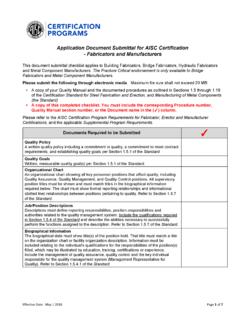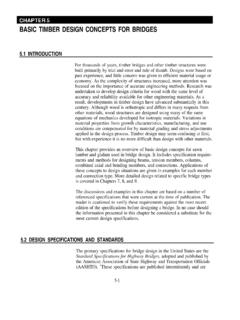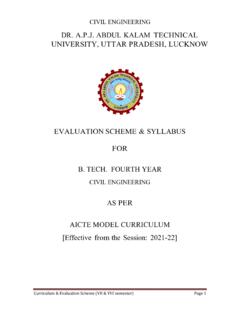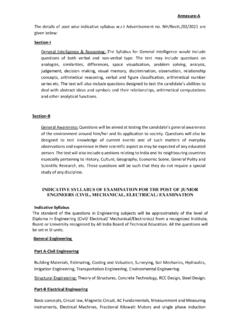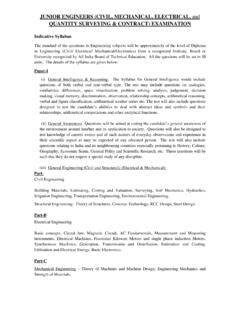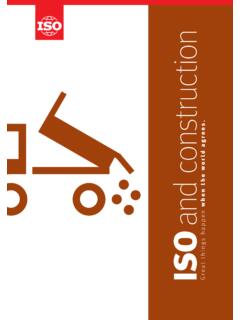Transcription of Evaluation of Existing Structures - AISC
1 WEvaluation of Existing StructuressteelwiseFebruary 2007 Structural documentation of an Existing building can give the engineer an idea of the building s original framing and assist with renovation connection toideas + answers WHAT DRAWINGS ARE AVAILABLE OF THE ORIGINAL structure ? That s the first question an engineer is likely to ask when confronted with a modification, rehabilitation, or retrofit of an Existing structure . Such documentation goes a long way in helping to assess a structure s capacity to accommodate Existing or anticipated loads. Structural drawings generally include physical plan layout, framing member sizes, references to material strengths, and design loads. This information is paramount to assessing the capabilities of the Existing structure and determining what must be done to accommodate the project requirements. The scope of investigation necessary to confirm Existing draw-ings or to develop as-built information is a matter of engineering judgment: What type of framing system was used?
2 Does the proj-ect involve only a small portion of a structure , or a major portion? Will the lateral-force-resisting system be affected by the proposed modifications? Is a change in occupancy planned? Is an increase in loading anticipated? Is a change in framing layout necessary? What is the age of the structure ? All of these factors will likely influence the TrailIf structural drawings of a building are available, then the first task generally becomes a matter of confirming that the Existing structure physically represents what is shown on the documents. If documentation is not available, the task then becomes much more difficult. This may necessitate an extensive field investigation pro-gram to develop as-built information. Understanding the nature of the structural framing systems and the thought processes of the building s original engineers should be a great help in developing the necessary information to evaluate the system capacities.
3 Any field investigation will require that structural components be physically accessible. Architectural enclosures of the structure (ceilings, walls, column finishes, etc.) will likely need to be removed in the areas slated for inspection. In a steel frame structure , once the coverings are removed and structural steel framing becomes visible, the investigator can make measurements of beam layouts and spacing, beam depths, flange thicknesses, and widths. Arrange-ments of applicable lateral-force-resisting systems, such as bracing, moment frames, or steel systems combined with concrete shear walls, can be viewed. This also provides an opportunity to take material samples for testing if necessary. The Way Things WereFamiliarity with the types of framing systems and associated design parameters used during a certain era of construction gives a better understanding of what to look for when evaluating a structure .
4 Economical and successful structural concepts have a tendency to be copied, so it is not surprising to find similar con-struction types used extensively during any particular era of con-struction. The height of a building was one factor that would have a large influence on the type of construction, and developments in construction technology played a major role in what height a building could early Structures were mostly bearing-wall systems sup-porting short-span horizontal framing. Masonry bearing walls supporting timber framing were common, as were complete verti-cal and horizontal wood framing systems. The desire to build to greater heights, often using masonry bearing walls, was enabled by the thickening of the masonry walls, especially at the base. As building heights increased, significant floor space was absorbed by the bearing the late 1800s, structural steel changed the character of high-rise construction.
5 Compared to previous commonly available structural materials, this new material was stronger, both in terms of tensile and compressive properties. The post and beam steel framing system was used to permit longer spans and greater build-ing heights. As buildings became higher, the lateral-force-resisting system also became more critical, and steel framing systems were developed using moment frames and vertical bracing. This was the beginning of the common skeletal frame type of construction. The 10-story Home Insurance Building, constructed in Chicago in 1885, was the first structure supported entirely by a steel frame in the and is often referred to as the first framing also varied widely depending on the construc-tion era. As steel skeletal frame construction evolved, so did floor system types in order to accommodate increasing spans. Flat tile-arch systems were widely used in conjunction with embedded steel beams in the late 19th and very early 20th centuries.
6 Concrete joist systems, formed with metal pans and supported by a skeletal steel frame encased in concrete, became quite common in the 1920s. Following World War II, metal deck systems were introduced that could function as stay-in-place forms used without ConsiderationsA prime factor in the Evaluation process is the strength of the steel that was used to construct the building. If the era of construc-tion is known, one can get a fairly good idea of the steel mate-rial strengths that were likely used. This can be accomplished by researching historical documents such as previous AISC specifica-tions and manuals and American Society for Testing and Materi-als (ASTM) material standards. A historical summary of ASTM standards was compiled for AISC and published in a book titled BY KURT GUSTAFSON, , FEBRUARY 2007 MODERN STEEL CONSTRUCTION MODERN STEEL CONSTRUCTION FEBRUARY 2007 Iron and Steel Beams 1873 to 1952.
7 AISC s design Guide 15 expands on this publication and includes a summary of documents through 2000. The design guide also contains additional historical infor-mation on AISC specifications and construction manuals, and has superseded Iron and Steel structural components could be found in the as early as the 1830s. These were of cast iron, a material of high compres-sive strength, low tensile strength, no clearly defined yield point, and brittle character. More ductile forms of cast iron were devel-oped and used in the 1850s, and later wrought iron in the 1870s. Cast iron structural components, mostly columns, were used into the early 20th century, but rarely in structural framing after about 1910. Structural steel, more ductile than cast iron and with more significant tensile capacity was introduced in the 1870s and quickly began replacing cast iron for structural applications.
8 Major producers of metal structural products developed load tables and published catalogs of information for the products they individually produced. Material standardization evolved when ASTM was founded in 1898 to address frequent rail breaks that were problematic in the then growing railroad industry. This work led to standardization of the steel used in rail construction. In 1900, ASTM developed standards for structural steel materials: ASTM A7 for bridges and ASTM A9 for buildings. These stan-dards defined minimum requirements for the steel materials used in these applications, bringing uniformity to the varying standards published by the individual producers of the time. The ASTM A7 and A9 standards were consolidated in 1939 into one ASTM A7 standard for bridges and buildings. This remained the primary structural steel standard until the early 1960s when ASTM A36 became the predominant structural steel used for building construction.
9 Other types of high-strength, low-alloy steels were also developed and permitted for use in the 1960s. Often, these higher-strength steels would be used for applications such as columns with significant axial load in high-rise buildings, or for specialized considerations such as weathering steels. ASTM A992, adopted in 1998, is the current standard for the common Table 1 ASTM and AISC (ksi) (ksi)Basic Working Stress1901A9 1909A9 1923A9 (not less than 33)181936A9 (not less than 33)201939A7 Buildings(and Bridges) (not less than 33)201942A7 WPB Emergency (not less than 33)20A36 (Supp.) (not less than 33) used today. The most tracked minimum requirements of the ASTM stan-dards for steel are the tensile and yield strengths of the material, which were and still are the basis of state requirements in design standards for structural steel. A review of the ASTM standards for the time era of a particular construction project will give a good idea of these basic yield and tensile strength parameters that were likely required at the time.
10 Note that there is no guarantee that some produced steel materials may have failed to meet the ASTM minimum requirements, particularly during the infancy of the material standardization process. Depending on the project parameters, it is an engineering judg-ment call whether some testing may be warranted to confirm that the strength of the materials meets ASTM minimum requirements. Keep in mind that the results of any test are only representative of that particular piece and may even vary as to where the sample was taken from the piece. Therefore, it is again a judgment call as to how many pieces should be sampled to give a level of confidence that the steel likely met the minimum ASTM requirements of the time. If structural drawings or project specifications are available that set requirements for the steel type, this may be an influencing factor in determining test program ConsistencyAs previously mentioned, allowable load tables were developed by individual companies for products made in the late 1800s and early 1900s.






